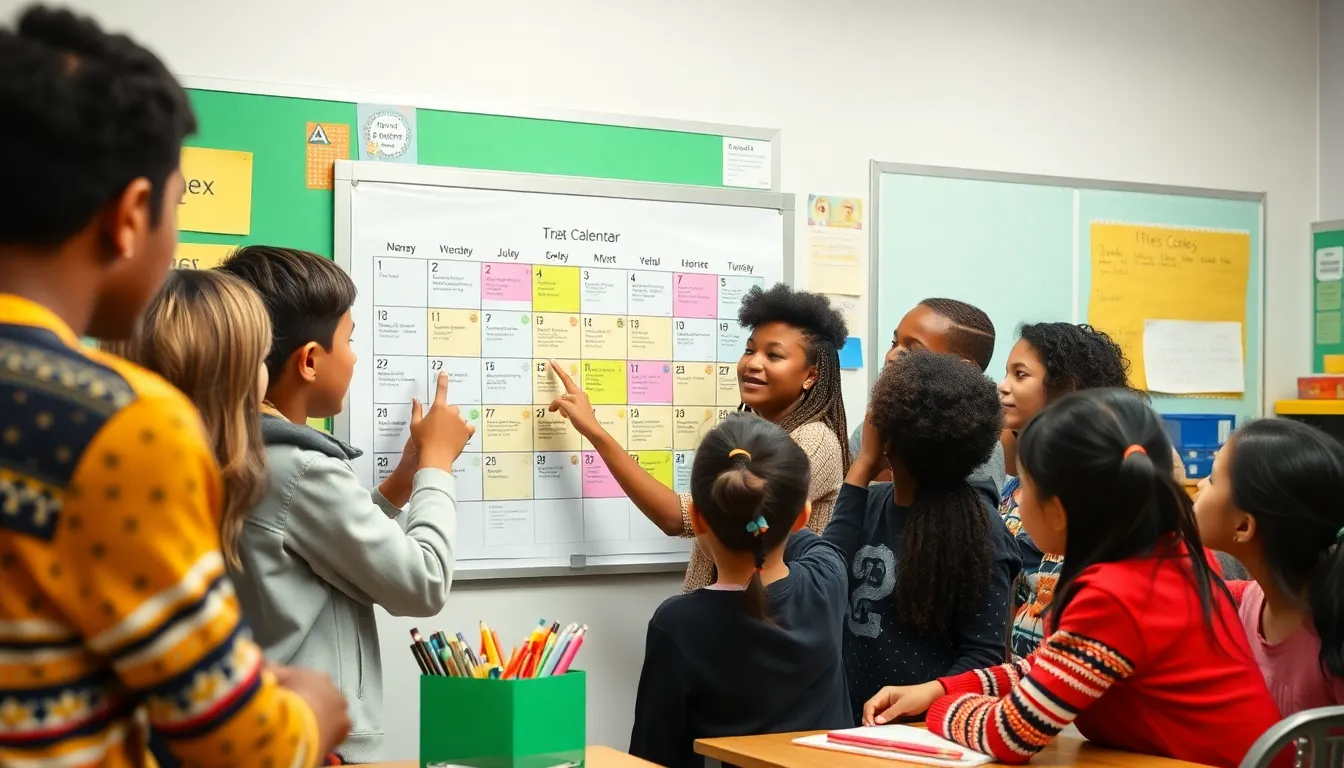Every year, students and parents brace themselves for the annual ritual known as the school calendar. It’s that sacred document that dictates when the alarm clock will become their worst enemy and when they can finally sleep in. But let’s face it—navigating the school calendar can feel like trying to solve a Rubik’s Cube blindfolded.
Table of Contents
ToggleOverview of School Calendars
School calendars serve as essential tools that shape the academic year for students and families. These calendars display critical dates, including holidays and breaks, impacting daily routines significantly.
Importance of School Calendars
School calendars provide a structured timeline for educational activities, helping families plan ahead. They facilitate communication between schools and parents, ensuring everyone stays informed about events. Scheduling vacations or extracurricular activities becomes more manageable with clear academic dates. Planning around holidays and breaks also ensures students and parents can maintain a balanced life. Schools use calendars to promote attendance and engagement throughout the school year.
Types of School Calendars
Various types of school calendars exist to accommodate different educational needs. Traditional school calendars typically run from late August to early June, aligning with standard academic schedules. Year-round calendars feature shorter breaks throughout the year and divide the academic year into multiple segments. Modified calendars may combine elements of both traditional and year-round systems, offering flexibility. Some schools implement block scheduling, allowing longer periods for fewer classes each day, enhancing instructional time. Lastly, online and digital calendars provide real-time updates and notifications for families.
Benefits of a Well-Structured School Calendar

A well-structured school calendar presents numerous advantages. It promotes better planning and organization for students, parents, and educators.
Academic Performance
A clear calendar improves academic performance by outlining important dates, including exams, holidays, and project deadlines. Students can manage their time effectively when they know when assignments are due. Teachers benefit from planned schedules. Predictable timelines allow them to cover necessary material without rushing. Consistency in scheduling helps students develop study habits. Enhanced preparation directly correlates with higher test scores and overall success.
Mental Health and Well-Being
Maintaining a structured calendar supports mental health and well-being. Predictability reduces anxiety among students and parents alike. Scheduled breaks provide necessary downtime, allowing students to recharge. Balanced timing helps avoid burnout, which is essential during intense study periods. Families can plan vacations and activities during school breaks, leading to shared experiences that strengthen relationships. Lastly, clear communication about deadlines fosters a supportive learning environment, enabling students to thrive emotionally.
Common Formats of School Calendars
School calendars exist in various formats, each serving unique scheduling needs for students, families, and educators.
Traditional Calendar
The traditional calendar aligns with the September to June academic year. It typically includes a summer break for approximately 10 to 12 weeks. Schools following this model often have two semesters, each separated by holiday breaks such as Thanksgiving and winter holidays. This format is familiar to most families and facilitates planning around summer vacations and activities. Community events and seasonal activities frequently coincide with these breaks.
Year-Round Calendar
A year-round calendar emphasizes continuous learning throughout the year. It redistributes vacations into shorter breaks that occur more frequently, usually every 6 to 9 weeks. This format minimizes summer learning loss, benefiting students by keeping their knowledge fresh. Families often adjust to smaller, more frequent breaks, allowing vacations to be scheduled in less crowded times of the year. Year-round schools are useful for addressing overcrowding, as they can stagger student attendance.
Modified Calendar
The modified calendar blends features from traditional and year-round formats. This schedule typically consists of two semesters separated by breaks that occur after shorter instructional periods. It allows for flexibility, accommodating families who may prefer longer breaks during specific times of the year. Modified calendars enhance continuous engagement by providing students with regular intervals of downtime while ensuring a structured learning experience. Schools adopting this format aim to balance academic rigor with opportunities for rest and family bonding.
Factors Influencing School Calendar Decisions
School calendars reflect various influences vital to their effectiveness. Understanding these factors helps in creating responsive and accommodating academic schedules.
Local Community Needs
Local demographic trends shape school calendar decisions. Schools often assess community preferences for seasonal breaks when drafting schedules. Parents often request holidays that align with family traditions or local events. Additionally, feedback from local businesses can affect decisions, as schools may aim to avoid scheduling conflicts with major community activities. Schools may adjust calendars to support local agricultural schedules, especially in rural areas where harvest times impact family availability. Collaboration between schools and community stakeholders ensures calendars meet educational needs while considering local culture.
Weather Considerations
Weather events considerably influence school calendar planning. Regions prone to severe winters might include built-in snow days to ensure student safety. Administrators utilize historical climate data to determine optimal scheduling for educational activities. Natural disasters also lead to calendar adjustments, enabling recovery periods for impacted communities. In areas with extreme heat, some schools may shift session times to cooler parts of the day. These proactive measures help enhance daily school operations and ensure student well-being amid varying weather conditions.
Conclusion
Navigating the complexities of a school calendar is crucial for students and families alike. A well-organized calendar not only streamlines daily routines but also fosters academic success and mental well-being. By understanding the various formats and their unique benefits, families can make informed decisions that align with their needs.
The importance of clear communication and flexibility in school calendars can’t be overstated. As educational systems continue to evolve, adapting calendars to meet community needs and environmental factors will enhance the overall learning experience. Ultimately, a thoughtfully designed school calendar serves as a foundation for effective planning and stronger family connections, ensuring that everyone can thrive throughout the academic year.



